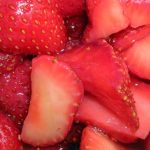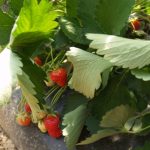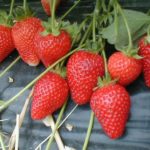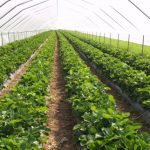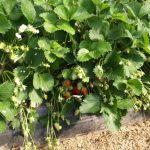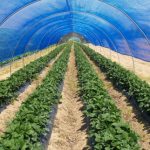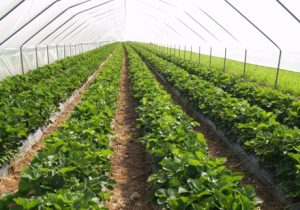
Name
Cuneo Strawberry
Seal of quality

Typical food-farming productDescription
“Fragola Cuneo” is intended solely for the fruits of the cultivars of Alba, Arosa, Asia, Clery, Record, Sugar Lia, Roxana, Albion, Charlotte, Diamante, Elsinore, Evie 2, Irma, and for the even more ameliorative clones of these varieties, grown in the area of origin.
The productions obtained with traditional in-soil cultivation techniques can bear the seal ” Fragola Cuneo “; therefore, cultivating carried out utilising out-of-soil production technologies are explicitly excluded.
The fruits must present minimum sugar content above 6° Bx associated with good juice acidity (minimum acidity, expressed as titrable acidity: not inferior to 7 meq/100 g di NaOH N/10).
The cultivated varieties belong to the group of strawberries called “unifero” (plant that produces fruits once a year), which produce in one only season of the year, or to the group of remontant strawberries which fruit from spring to autumn. This is why strawberries are present from the end of April (“unifero” strawberries grown in greenhouses) till the end of October (remontant strawberries).
Nutritional characteristics
Strawberries are low calorie content (only 27 per 100g), and are a fair source of fibres and a good source of vitamin C, average content of minerals (among which potassium and phosphor). They have always been known for their digestive, depurant and refreshing properties.
| FOOD | unit of measurement | Strawberry |
|---|---|---|
| Edible part | % | 94 |
| Water | G | 90,5 |
| Protein | G | 0,9 |
| Fat | G | 0,4 |
| Carbohydrates | G | 5,3 |
| Starch | G | 0 |
| Soluble sugar | g | 5,3 |
| Total fibre | g | 1,6 |
| Energy | kcal | 27 |
| Kilojoules | kJ | 113 |
| Sodium | mg | 2 |
| Potassium | mg | 160 |
| Iron | mg | 0,8 |
| Calcium | mg | 35 |
| Phosphor | mg | 28 |
| Thiamine | mg | 0,02 |
| Riboflavin | mg | 0,04 |
| Niacin | mg | 0,5 |
| Vit A ret. eq. | mcg | tr |
| Vit C | mg | 54 |
| Vit E | mg |
Area of production
The area of production and impact of the ” Fragola Cuneo ” is identifiable with the area which extends along the northern alpine ridge between the Maritime and Cottian Alps, at an altitude ranging from 250 and 1700 metres above sea level, and is characterised by areas in the province of Cuneo with a historic vocation for cultivation, from the Po to the Tanaro Valleys and the high adjoining plains.
History
The Piedmontese climatic conditions, which characterise the Cuneo region, have enabled these strawberries, in time, to spread over many hilly area; at first the strawberries grew spontaneously then, in time, began to be grown rationally. Throughout the centuries, they have been used both as a food product particularly rich in nutritional elements and as herbal medicine – pharmacopoeia for the preparation of herbal teas and /or for treatment of particular diseases. Greater and greater quantities of the spontaneous product, which is the most widespread in this region, are being picked. This is due not only to the work of the farmers of the past, but also to the tireless activities of the Carthusians who, in 1173, came to settle in a mountain area at the doors of Cuneo, an area particularly rich in spontaneous flora. Account of this is found in a publication dated 1884 (reprinted in 1892) by av. Prof. D. Giambattista Botteri “Memorie storiche e antichi statuti di Chiusa Pesio”.
The picking of spontaneous fruits, especially undergrowth, continued into the middle 40s when, in the Peveragno area, there began the first experiences of rational growing of this exquisite fruit, using spreading materials coming from neighbouring France .
Due to the insight of the farm workers and the hard work of the entire valley, strawberry growing developed and, within a few years, reached significant diffusion, representing a primary source of income for many farmers of a vast part of the province.
In the 60s and 70s, investments close to 1,400 acres were reached with productions of approximately 15,000 tons/year intended for the domestic market and for export to Switzerland and/or Germany .
Today, strawberry growing still represents an important source of income for many growers situated in the disadvantaged mountain areas.
At the present time, it is estimated that the cultivation extends over approx. 200 ha , using both the “unifero” and the diurnal neutral cultivars, whereas the average annual production is estimated at approx. 7,000 tons. The introduction of the product on the market carried out by approx. 300 farms, takes place throughout the summer-autumn period (from April to November), both through structures of an associated form present in the area, and through local trade operators and/or markets of origin.
The “Consorzio per la valorizzazione e la tutela della Fragola Cuneo” was founded for this purpose, based in Cuneo, Via Bruni 5.
